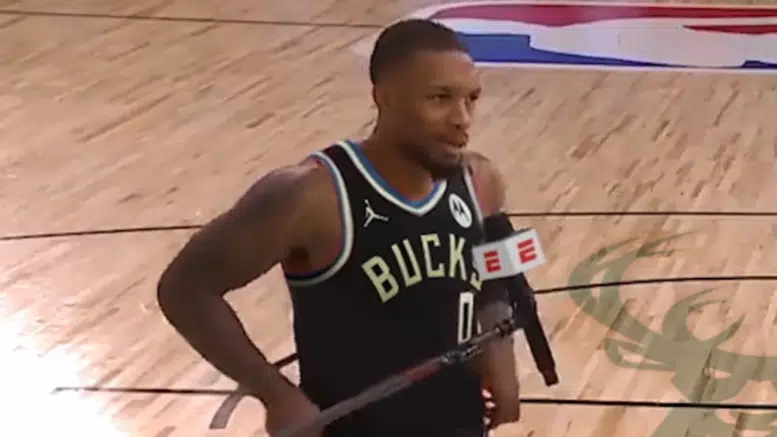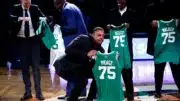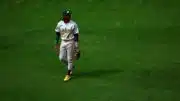Last week, after the Bucks’ opening night win against Philadelphia, fans were treated to a video of Damian Lillard talking about why he wanted to head to the heartland to play with Milwaukee and Giannis Antetokounmpo. “Ain’t nothing I want more,” Lillard said. “I told you when I first came here, I ain’t come here to waste my time.” It’s a great sound byte from a player who finally has a real shot at winning an NBA Championship. The kind of mic-drop moment those of us who work in sports media are always looking for to share on social media. The problem is that Lillard never said it. Or at least not any time in the last two years. And he wasn’t even talking about Milwaukee.
The video, which features Lillard fiddling with his Bucks jersey while an ESPN mic is extended out in front of him, was actually recorded in the NBA Bubble back in 2020 when Lillard was still with the Trailblazers. Turns out, ESPN digitally altered the video — replacing the reporter interviewing Dame with an ESPN mic and putting Lillard in a Bucks uni — and then tweeted it out after the game as if it had just happened. Take a look:
ESPN owned up to the digital alteration, releasing a statement that said, “We occasionally look to connect sports moments of the past with contemporary imagery and storylines as part of our social content. While it was never our intention to misrepresent anything for fans, we completely recognize how this instance caused confusion.”
Actually, it seems that misrepresentation was exactly the goal of the video, otherwise why alter it to make it look like Dame was wearing Bucks gear and standing on the floor in Milwaukee? And let’s be honest, while this is a fun little moment, we’re not exactly talking about a “sports moment of the past” like John Carlos and Tommie Smith’s Black Power Salute in Mexico City or Billie Jean King beating Bobby Riggs. There was zero reason for ESPN to create this video, other than the never-ending quest for clicks, and shares on social media. And the failure to alert their readers to the alteration makes the entire post damn near unforgivable.
The ethical problems revealed by ESPN’s inexplicable lack of judgment are complex but illustrative of the battle currently being waged in sports media, and in news media overall. First, there’s the problem of much of society seeing sports as entertainment, rather than news. If you justify sports as a space where people come to have fun — especially NBA Twitter, TikTok, and Instagram, which is undefeated in terms of passionate fans who continually make hilarious memes and videos — then pretty much anything is ethical, right? After all, we’re all just having fun; no one thinks any of this is real. And that’s very much the attitude had been many in the sports media space including, apparently, whoever green-lighted the Dame video at ESPN. And with the loss of shows that featured actual investigative reporting in sports, like ESPN’s Outside the Lines and HBO’s Real Sports, the space for real journalism in sports media continues to shrink.
I had a friend who recently interviewed for a job as a “content creator” at a major legacy media outlet, once known for its top-notch reporting on world events. His prospective job wasn’t to be a journalist, per se, it was to aggregate, and churn out stories others had already done across the web. His boss wasn’t a journalist, either. He was a “Senior Content Creator.” And this brings us to the second problem with what’s going on in the wide world of sports — journalists are valued less than social media “creators,” the current darlings of an increasing number of media outlets. But journalists and “creators” are not the same.
I say this not to gatekeep the profession. Plenty of great journalists never went to journalism school or trained in a newsroom. But the difference is that journalists, ideally, are bound by a code of ethics that is beaten into them, if not by their J-school, by more senior colleagues. Journalists have editors and fact-checkers and are bound by moral and professional obligations to tell the truth. And while it’s certainly valid to point out that not everyone in media sees “truth” the same way, I’d like to believe that most journalists would see a co-worker saying, “Hey, I’ve got an idea. Let’s use AI to make it look like Dame said all this tonight and then slap it up on social media without alerting our audience that’s it’s been altered” as a giant, flashing red light.
But the real problem here is that “success” in journalism, these days, is measured in clicks. A story can break news that is important to our world and the way we live in it, but if it doesn’t rocket up to the top of Chartbeat (an analytics tool many outlets use to measure traffic), the story is deemed a failure by the powers that be who, increasingly, are not from the world of journalism at all. Lots of clicks on social media means more social media followers. More social media followers means more eyes on the links to stories. More eyes on stories means more eyes on the ads that pop up — much to the agony of journalists — all over the outlet’s website. More eyes on the ads means the outlet can charge more for ads. And more ad money means bigger bonuses for the non-journalism side of the company (because they sure aren’t giving raises or bonuses to journalists). And that’s the current model for most media outlets.
And you know what doesn’t cost nearly as much as a journalist’s annual salary or sending a reporter out into the field to chase stories? An AI bot.
Despite dozens of people calling out ESPN within moments of the Dame video going up, I’ll bet they got enough clicks and views on that post to make it worth their while, especially once the controversy made the rounds. And while I don’t know the current hierarchy of ESPN’s NBA social media team, I find it hard to believe that there was a single person with a journalism background in the room when that decision was made. And let’s be clear — posting the Lillard video was a form of news reporting. ESPN was “reporting” to their fans what they purported Dame said about Milwaukee after the game. Later claiming “We never said he was talking about Milwaukee” is the kind of juvenile game that I expect from TMZ and Page Six, but not ESPN.
But with actual journalism not paying for the giant bonuses of media titans these days, expect to see fewer journalists, and more content creators — and more AI-generated content — in the news you consume. And hey, there’s nothing wrong with being a content creator. I love funny sports memes and social media posts as much as the next person. There’s certainly a place for creative media in sports which, after all, is supposed to be fun. But that place is not disguised as news and altered to intentionally mislead the audience.
If you, as a fan, object to being served re-heated clips and stories, sometimes created, or altered by AI, as “news,” the time to start making a lot of noise about it is right now. Soon, we’ll have gone so far over the edge there’ll be no coming back. And “journalism,” as we understand it today, will have ceased to exist.
Original source here
#ESPN #care #deepfaked #Damian #Lillard #interview





